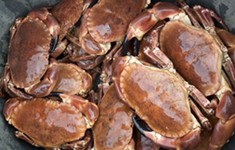 Tackling the challenges that face the European brown crab industry is a long overdue task, but one that is finally in hand, thanks to a collaborative 3-year, European INTERREG-funded project which involves partners from Ireland, United Kingdom, France, Spain and Portugal. The project, known as ACRUNET — the Atlantic crab resource users’ network — aims to tackle everything from continuity of supply to adding value.
Tackling the challenges that face the European brown crab industry is a long overdue task, but one that is finally in hand, thanks to a collaborative 3-year, European INTERREG-funded project which involves partners from Ireland, United Kingdom, France, Spain and Portugal. The project, known as ACRUNET — the Atlantic crab resource users’ network — aims to tackle everything from continuity of supply to adding value.The brown crab industry is worth around GBP 56 million (USD 87 million, EUR 64.6 million) annually at first sale value but could be worth a great deal more, according to project coordinator Norah Parke from the Killybegs Fishermen's Organization Ltd in Ireland.
“The network has been a long time coming and we have great expectations from it,” she said. “We have been talking to other crab producing and using countries about common issues since 2008, but it took another four years to turn those discussions into a meaningful project.”
The U.K. currently lands around 25,000 metric tons (MT) of brown crab, with a sales value of GBP 30.5 million (USD 47 million, EUR 35 million), accounting for more than half of total European value. In the past three years, landings have risen by 16 percent in volume, and 27 percent in value. Irish landings make up 15 percent of the value and French landings 13 percent.
France and Spain play a major role in the purchase and distribution of crab, but processing and value adding activities are spread across all the countries.
Parke explained that value also accrues to the partner countries through transportation, live holding facilities and processing, but compared with similar artisanal high quality seafood such as lobster and langoustine, the market is under-exploited. It also suffers from frequent gluts with a consequent lowering of prices to fishermen, which results in greater market fragility.
There appears to be a general lack of trust between different sectors of the complex fishery, with large offshore “super crabbers” competing with the smaller inshore vessels and disagreements arising over the fishing pressure on certain stocks. In addition, rising fuel costs, high bait costs, increased regulation, quality issues related to catching, handling and transportation, imports of cheaper crab products and the financial crisis in the traditional European markets, all combine to undermine the profitability of the industry.
“One of the first tasks for the project is to undertake a thorough analysis of the brown crab production chain, to identify areas where savings can be made or value added. We also want to develop an accredited European brown crab standard, which will encompass responsible fishing methods, traceability and quality,” explained Parke.
Other aspects of the project include setting up an industry/science interface that will improve and inform management of the resource, introduce innovative practices and products to enhance competitiveness, and increase the market presence of brown crab throughout the European market.
Each country is currently producing a SWOT analysis of its industry as part of the analytical phase of the project. According to Seafish, which is one of the U.K. partners, the domestic retail market is not large for crab, with the majority of sales made of up fresh and ambient products and a small proportion of frozen. Key retailers for crab products are Waitrose, Morrisons and Marks & Spencer, and nearly half of all crab products are sold in the more affluent southeast area of the U.K., which includes London.
In the food service market, crab remains fairly static at 2 percent of out of home seafood servings, with crab cakes being a key product format.
More than two-thirds of U.K. landed crab is exported to France (36 percent) and Spain (37 percent), with Portugal and Italy taking minor amounts. China is a small but rapidly growing market for brown crab, and between 2009 and 2011, U.K. exports of brown crab to China increased from 139 to 333 MT (139 percent) whilst the value increased from GBP 345,000 (USD 532,292; EUR 397,852) to GBP 2.3 million (USD 3.5 million, EUR 2.7 million) (558 percent). This significant increase is in line with China’s growing demand for all types of seafood and is a market that an increasing number of producers are targeting.





